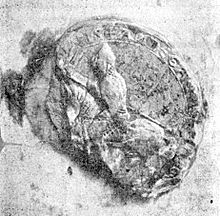Fulk III of Anjou facts for kids
Fulk III "Nerra" (born around 970, died 1040) was an important French nobleman. He was the Count of Anjou from 987 until his death. Fulk was known for making the Anjou region very powerful. He did this by building many castles across his lands. His nickname "Nerra" meant 'the Black', and he probably got it after he died.
Contents
Early Life and Becoming Count
Fulk was the son of Geoffrey I, Count of Anjou and Adele of Meaux. He was born around the year 970. Fulk came from a long line of counts; his father, grandfather, and great-grandfathers had all been counts of Anjou before him. His father, Geoffrey I, prepared Fulk to take over as count.
When Fulk was about 17, his father died, and Fulk became the new count. Two years earlier, in 985, his father had arranged for Fulk to marry Elizabeth de Vendome. She was the daughter of Bouchard, Count of Vendome.
Count of Anjou: Challenges and Triumphs
Fulk's first years as count were very challenging. He had to constantly fight to protect his lands, especially his western borders and his areas in Touraine. His main goal was to hold onto and defend the interests of Anjou.
Fulk also faced problems from the church. Bishop Renaud of Angers and Guntarius of St. Aubin thought they could take advantage of a young, new count. They wanted to get back lands that Fulk's father, Geoffrey, had taken from them. But Fulk had a strong helper in his uncle, Bishop Guy of Le Puy. Guy stepped in and helped Fulk deal with these church leaders.
Battles and Expanding Power
Fulk fought against Conan I of Rennes at the Battle of Conquereuil on June 27, 992. Conan was a powerful leader, even though he had lost a battle to Fulk's father years before. By defeating and killing Conan, Fulk Nerra gained a reputation as a very skilled military leader. After this victory, Fulk expanded his power over the regions of Maine and Touraine.
Rivalry with Odo II of Blois
Fulk Nerra had a long-standing rivalry with Odo II, Count of Blois. The French king, Hugh Capet, had supported Fulk's family against Blois. However, the next king, Robert II of France, was married to Bertha, Odo II's mother. This meant King Robert supported Blois against Anjou. The king did not like Fulk's plans for Touraine, which forced Fulk to pull back to Anjou.
When Fulk went on a trip to the Holy Land, Odo II tried to take advantage. He built three new castles to challenge those built by Fulk. Later, King Robert II married again, this time to Constance of Arles, who was Fulk's cousin. This improved relations between the king and Fulk.
A conflict arose when Count Hugh of Beauvais, a favorite of King Robert, spoke against the new queen, Constance. This led to a serious disagreement between Fulk and the king, and also with the church. To make amends, Fulk went on a trip to the Holy Land (he made four such trips in total). When he returned, he built a new monastery. The king decided to stay with Constance, and he and Fulk made up in Rome in 1016.
That same year, war broke out again between Fulk and Odo II of Blois. Fulk teamed up with Herbert I, Count of Maine, also known as Wakedog. They attacked the city of Tours. Odo II came to respond, and the two armies met on July 6, 1016. Even though Herbert Wakedog was knocked off his horse, he was rescued. Fulk defeated Odo II at the Battle of Pontlevoy.
Odo II later lost favor with King Robert. The king asked Fulk to help him against Odo II, which Fulk did. In 1026, when Odo II was trying to take Montboyau, Fulk Nerra attacked Saumur. Fulk managed to keep Saumur, while Odo II lost Montboyau. In the later part of his rule, Fulk gained more land in the south, including much of Poitou, and built a castle there to protect his interests.
Building Castles
To defend his territory, Fulk built many castles and other strongholds. Fulk used these castles for both attacking and defending. Some of his fortresses were built in ways that divided the land of a neighboring lord. Others were used as forward bases for attacking Touraine.
In 1028, Fulk and his second wife, Hildegarde, founded the abbey of Le Ronceray. It was originally a church dedicated to St. Mary. Hildegard was very active in rebuilding it into an abbey. They gave the abbey many gifts, including the forest of Lattay.
Fulk died on April 1, 1040, while returning from his last pilgrimage.
Family Life
Fulk's first wife was Elizabeth de Vendome. They had one daughter:
- Adèle. She married Bodon de Nevers, who became count of Vendome through his marriage.
His second wife was Hildegard of Lorraine. Together, they had two children:
- Geoffrey Martel, who became count after Fulk.
- Ermengarde-Blanche.
Images for kids
See also
 In Spanish: Fulco III de Anjou para niños
In Spanish: Fulco III de Anjou para niños



